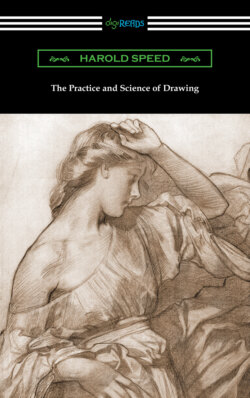Читать книгу The Practice and Science of Drawing - Harold Speed - Страница 36
На сайте Литреса книга снята с продажи.
VI. THE ACADEMIC AND CONVENTIONAL
ОглавлениеThe terms Academic and Conventional are much used in criticism and greatly feared by the criticised, often without either party appearing to have much idea of what is meant. New so-called schools of painting seem to arrive annually with the spring fashions, and sooner or later the one of last year gets called out of date, if not conventional and academic. And as students, for fear of having their work called by one or other of these dread terms, are inclined to rush into any new extravagance that comes along, some inquiry as to their meaning will not be out of place before we pass into the chapters dealing with academic study.
It has been the cry for some time that Schools of Art turned out only academic students. And one certainly associates a dead level of respectable mediocrity with much school work. We can call to mind a lot of dull, lifeless, highly-finished work, imperfectly perfect, that has won the prize in many a school competition. Flaubert says “a form deadens,” and it does seem as if the necessary formality of a school course had some deadening influence on students; and that there was some important part of the artist’s development which it has failed to recognise and encourage.
The freer system of the French schools has been in many cases more successful. But each school was presided over by an artist of distinction, and this put the students in touch with real work and thus introduced vitality. In England, until quite lately, artists were seldom employed in teaching, which was left to men set aside for the purpose, without any time to carry on original work of their own. The Royal Academy Schools are an exception to this. There the students have the advantage of teaching from some distinguished member or associate who has charge of the upper school for a month at a time. But as the visitor is constantly changed, the less experienced students are puzzled by the different methods advocated, and flounder hopelessly for want of a definite system to work on; although for a student already in possession of a good grounding there is much to be said for the system, as contact with the different masters widens their outlook.
But perhaps the chief mistake in Art Schools has been that they have too largely confined themselves to training students mechanically to observe and portray the thing set before them to copy, an antique figure, a still-life group, a living model sitting as still and lifeless as he can. Now this is all very well as far as it goes, but the real matter of art is not necessarily in all this. And if the real matter of art is neglected too long the student may find it difficult to get in touch with it again.
These accurate, painstaking school studies are very necessary indeed as a training for the eye in observing accurately, and the hand in reproducing the appearances of things, because it is through the reproduction of natural appearances and the knowledge of form and colour derived from such study that the student will afterwards find the means of giving expression to his feelings. But when valuable prizes and scholarships are given for them, and not for really artistic work, they do tend to become the end instead of the means.
It is of course improbable that even school studies done with the sole idea of accuracy by a young artist will in all cases be devoid of artistic feeling; it will creep in, if he has the artistic instinct. But it is not enough encouraged, and the prize is generally given to the drawing that is most complete and like the model in a commonplace way. If a student, moved by a strong feeling for form, lets himself go and does a fine thing, probably only remotely like the model to the average eye, the authorities are puzzled and don’t usually know what to make of it.
There are schools where the most artistic qualities are encouraged, but they generally neglect the academic side; and the student leaves them poorly equipped for fine work. Surely it would be possible to make a distinction, giving prizes for academic drawings which should be as thoroughly accurate in a mechanical way as industry and application can make them, and also for artistic drawings, in which the student should be encouraged to follow his bent, striving for the expression of any qualities that delight him, and troubling less about mechanical accuracy. The use of drawing as an expression of something felt is so often left until after the school training is done that many students fail to achieve it altogether. And rows of lifeless pictures, made up of models copied in different attitudes, with studio properties around them, are the result, and pass for art in many quarters. Such pictures often display considerable ability, for as Burne-Jones says in one of his letters, “It is very difficult to paint even a bad picture.” But had the ability been differently directed, the pictures might have been good.
